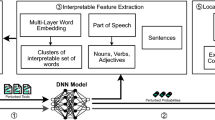Abstract
This paper describes the experimental evaluation of several attribution methods on two NLP tasks: Sentiment analysis and multi-label document classification. Our motivation is to find the best method to use with Transformers to interpret model decisions. For this purpose, we introduce two new evaluation datasets. The first one is derived from Stanford Sentiment Treebank, where the sentiment of individual words is annotated along with the sentiment of the whole sentence. The second dataset comes from Czech Text Document Corpus, where we added keyword information assigned to each category. The keywords were manually assigned to each document and automatically propagated to categories via PMI. We evaluate each attribution method on several models of different sizes. The evaluation results are reasonably consistent across all models and both datasets. It indicates that both datasets with proposed evaluation metrics are suitable for interpretability evaluation. We show how the attribution methods behave concerning model size and task. We also consider practical applications – we show that while some methods perform well, they can be replaced with slightly worse-performing methods requiring significantly less time to compute.
Access this chapter
Tax calculation will be finalised at checkout
Purchases are for personal use only
Similar content being viewed by others
Notes
- 1.
Different activation, slightly different layer operation.
- 2.
References
Bach, S., Binder, A., Montavon, G., Klauschen, F., Müller, K.R., Samek, W.: On pixel-wise explanations for non-linear classifier decisions by layer-wise relevance propagation. PLoS ONE 10(7), e0130140 (2015)
Bhargava, P., Drozd, A., Rogers, A.: Generalization in nli: Ways (not) to go beyond simple heuristics. In: Proceedings of the Second Workshop on Insights from Negative Results in NLP, pp. 125–135 (2021)
Chefer, H., Gur, S., Wolf, L.: Transformer interpretability beyond attention visualization, pp. 782–791 (2021)
Denil, M., Demiraj, A., Kalchbrenner, N., Blunsom, P., de Freitas, N.: Modelling, visualising and summarising documents with a single convolutional neural network. arXiv preprint arXiv:1406.3830 (2014)
Devlin, J., Chang, M.W., Lee, K., Toutanova, K.: BERT: Pre-training of deep bidirectional transformers for language understanding. In: Proceedings of the 2019 Conference of the North American Chapter of the Association for Computational Linguistics: Human Language Technologies, Volume 1 (Long and Short Papers), pp. 4171–4186. Association for Computational Linguistics, Minneapolis, Minnesota, June 2019. https://doi.org/10.18653/v1/N19-1423, https://aclanthology.org/N19-1423
DeYoung, J., Jain, S., Rajani, N.F., Lehman, E., Xiong, C., Socher, R., Wallace, B.C.: Eraser: a benchmark to evaluate rationalized nlp models. In: Proceedings of the 58th Annual Meeting of the Association for Computational Linguistics, pp. 4443–4458 (2020)
Kocián, M., Náplava, J., Štancl, D., Kadlec, V.: Siamese bert-based model for web search relevance ranking evaluated on a new czech dataset. arXiv preprint arXiv:2112.01810 (2021)
Kral, P., Lenc, L.: Czech text document corpus v 2.0. In: Proceedings of the Eleventh International Conference on Language Resources and Evaluation (LREC 2018). European Language Resources Association (ELRA), Paris, France, May 2018
Shrikumar, A., Greenside, P., Kundaje, A.: Learning important features through propagating activation differences. In: International Conference on Machine Learning, pp. 3145–3153. PMLR (2017)
Shrikumar, A., Greenside, P., Shcherbina, A., Kundaje, A.: Not just a black box: Learning important features through propagating activation differences. arXiv preprint arXiv:1605.01713 (2016)
Sido, J., Pražák, O., Přibáň, P., Pašek, J., Seják, M., Konopík, M.: Czert-czech bert-like model for language representation. In: Proceedings of the International Conference on Recent Advances in Natural Language Processing (RANLP 2021), pp. 1326–1338 (2021)
Simonyan, K., Vedaldi, A., Zisserman, A.: Deep inside convolutional networks: Visualising image classification models and saliency maps. arXiv preprint arXiv:1312.6034 (2013)
Smilkov, D., Thorat, N., Kim, B., Viégas, F., Wattenberg, M.: Smoothgrad: removing noise by adding noise. arXiv preprint arXiv:1706.03825 (2017)
Socher, R., et al.: Recursive deep models for semantic compositionality over a sentiment treebank. In: Proceedings of the 2013 Conference on Empirical Methods in Natural Language Processing, pp. 1631–1642 (2013)
Sofaer, H.R., Hoeting, J.A., Jarnevich, C.S.: The area under the precision-recall curve as a performance metric for rare binary events. Methods Ecol. Evol. 10(4), 565–577 (2019)
Sundararajan, M., Taly, A., Yan, Q.: Axiomatic attribution for deep networks, pp. 3319–3328 (2017)
Turc, I., Chang, M.W., Lee, K., Toutanova, K.: Well-read students learn better: On the importance of pre-training compact models. arXiv preprint arXiv:1908.08962 (2019)
Wang, A., Singh, A., Michael, J., Hill, F., Levy, O., Bowman, S.R.: Glue: a multi-task benchmark and analysis platform for natural language understanding. In: 7th International Conference on Learning Representations, ICLR 2019 (2019)
Acknowledgements
This work has been supported by the Technology Agency of the Czech Republic within the ETA Programme - No. TL03000152 “Artificial Intelligence, Media, and Law”, and by Grant No. SGS-2022-016 Advanced methods of data processing and analysis. Computational resources were supplied by the project “e-Infrastruktura CZ” (e-INFRA CZ LM2018140) supported by the Ministry of Education, Youth and Sports of the Czech Republic.
Author information
Authors and Affiliations
Corresponding author
Editor information
Editors and Affiliations
Rights and permissions
Copyright information
© 2022 Springer Nature Switzerland AG
About this paper
Cite this paper
Bartička, V., Pražák, O., Konopík, M., Sido, J. (2022). Evaluating Attribution Methods for Explainable NLP with Transformers. In: Sojka, P., Horák, A., Kopeček, I., Pala, K. (eds) Text, Speech, and Dialogue. TSD 2022. Lecture Notes in Computer Science(), vol 13502. Springer, Cham. https://doi.org/10.1007/978-3-031-16270-1_1
Download citation
DOI: https://doi.org/10.1007/978-3-031-16270-1_1
Published:
Publisher Name: Springer, Cham
Print ISBN: 978-3-031-16269-5
Online ISBN: 978-3-031-16270-1
eBook Packages: Computer ScienceComputer Science (R0)




